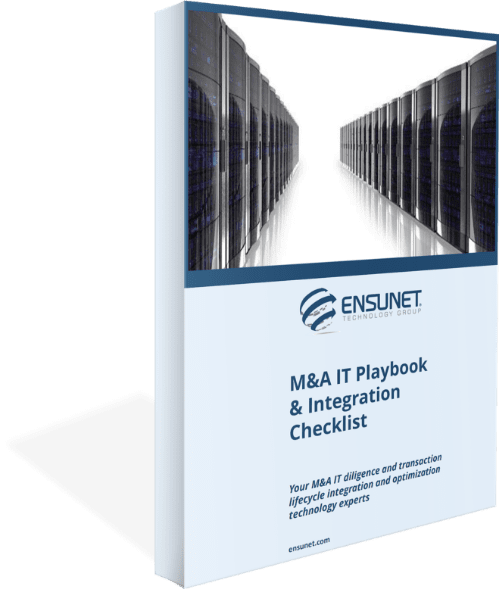M&A IT Playbook & Integration Checklist
Free M&A IT Playbook & Integration Checklist

M&A IT Playbook & Integration Checklist


Even the smartest serial acquirers need help wrangling data
We recently wrote about a software company that needed help with its enterprise resource planning, or ERP, system—dispelling the notion that a tech company can do all its own IT, especially when it’s caught in the whirlwind of mergers and acquisitions.
This story builds upon that one. Ensunet was recently called in to help a respected SaaS (software-as-a-service) company that needed help wrangling lots of financial data to the point where they could effectively use it to drive smart business decisions.
This company has a history of growing both organically and inorganically, i.e., by acquiring other companies. Incidentally, the company itself is a portfolio asset of a well-known private equity (PE) firm. So “financial transparency” is key here.
The problem was that they lacked it.
Staying in your swim lane
As we mentioned, this company creates a B2B SaaS offering: a smart, available-anywhere platform and suite of products for a specific professional market. (We can’t get too specific in these case studies, for obvious reasons.)
Remember: SaaS stands for “software as a service.” Which means that this client creates original software for the original content that they also create and sell. The entire operation is cloud-based. They’ve been at this for decades. They’re not exactly slouches.
If you’re a PE or other acquirer, this might mislead you during due diligence. “They have it all sewn up, right?”
Not exactly. There are tech things they specialize in—such as, obviously, that homebrew SaaS system—but there are others that they don’t. Such as finance.
And thus “finance” was the ambit for this Phase 1 engagement. If we succeeded with this one, we’d be green-lit for Phase 2, which includes HR and Sales (which should give you some insight into “other IT issues that SaaS companies don’t specialize in.”) But that was a tall order. Because this was a tricky one.
What’s hiding in the data?
The client had a good-sized wish-list of things they wanted at their fingertips, expressed as key performance indicators or KPIs. These included:
Better yet, they wanted these KPIs expressed visually. How can you spot trends, or make decisions, based on a spreadsheet?
To their credit, they had been wrestling with this problem for some time, and had developed some makeshift “solutions.” For example, if someone wanted a bookings report, they’d try and manually pull the data from the different sources (remember, this company had acquired other companies, and their systems), and then try and put that into Excel and then try and manipulate it into a table, and then try and put that into PowerPoint in order to present it.
That’s a lot of “trying.” It was also incredibly laborious, hugely time-consuming, and unsettlingly error-prone.
This is why they wanted to move everything to Tableau Online. Which is why we at Ensunet were brought in.
Tableau is what’s known as a business-intelligence platform. It’s able to take all kinds of disparate data, from lots of different sources (up to 345, to be exact), and then crunch and process it in the background, in real time, and present it all as easy-to-understand visual dashboards that are also dynamic: You can, say, drill down from country-wide sales bookings, down to the state, then territory, then individual sales rep, to the actual customers in their book. Accessible from any computer, tablet, or phone, it’s easy and intuitive.... once it’s set up properly.
Where is the data?
That “once it’s set up properly” is a huge caveat. It’s a classic case of the old “GIGO” adage: “garbage in, garbage out.” If you can’t set up Tableau properly, it won’t work miracles. It won’t even work.
This points up the very hardest part of the engagement. The data was all over the place. We needed Tableau to be able to query:
The system of record was Oracle, but there were plenty of others. These included Salesforce and its “Tableau wanna-be” Splunk add-on; Microsoft Dynamics, with various sub-systems and sub-ledgers plugged into it; Marketo; Paycom; UserIQ; and Survey Monkey, just to name a few. Not all of these systems are designed to be easily queried by Tableau, which requires some deft coding to overcome.
But that’s just the technical side. The far bigger issue is the KPIs themselves, and the availability of the data to even create them. One system might report sales of $10 million—but if another reports sales of “$999,999,” where’s that missing dollar? Everything needed to reconcile.
Similarly, KPIs are built upon definitions, and these required agreement. Remember the “acquisition cost per customer” KPI we’d mentioned above? Don’t take it for granted. What, exactly, is a “customer”? It’s not as simple as it seems:
This is the part of IT that’s about a lot more that systems and data. It’s about working with client subject matter experts or SMEs and forging consensus in order to create a solid foundation to build upon.
A whole new world
It took a lot of work, but we were able to get agreement on the KPIs. We got all of the data properly structured. We wrote the code for the custom queries. We worked the client to define and ascertain proper roles and assignments for access to the new system. We built the Tableau dashboards and deployed them to a pilot group of test users and got their feedback before rolling them out—including training—to the wider client community.
Incidentally, we did all of this remotely, given pandemic travel restrictions (not to mention budget savings).
Today, the client has instant, inarguable information at their fingertips. They can spot trends and make proactive decisions. They can zoom out for big-picture perspective, or drill down for granular insights, with just a click. They have the confidence that the information they’re seeing is both up-to-date and accurate. They’re prepared to take on more acquisitions. And they’ve reduced their manual finance-wrangling effort by an astonishing 90 percent, while eliminating errors altogether.
And as for Ensunet? Suffice to say, we’re already helping them with Phase 2.
Reach out to the world’s most reliable IT services.